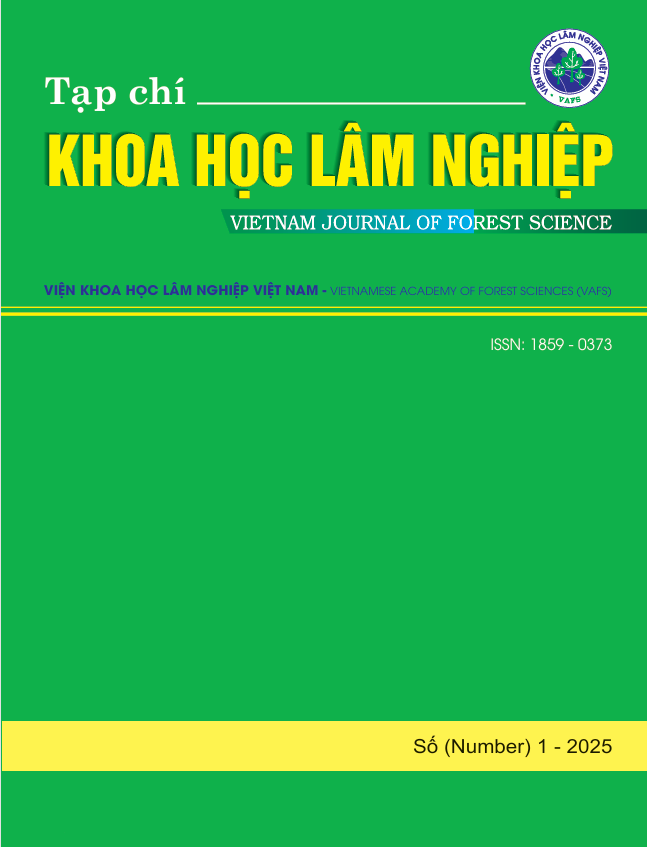1 SPECIES COMPOSITION OF VASCULAR PLANT SPECIES IN SOME MINING WASTE DUMPS IN NORTHERN VIETNAM
DOI:
https://doi.org/10.70169/VJFS.1017Keywords:
Mining waste dumps, heavy metal, plants, pollution treatmentAbstract
Choosing plant species to grow in mining waste dumps is known to be a challenging task because the soil after mining is often dry and low nutrient content. To provide a scientific basis for selecting plant species that can survive on mining waste dumps in the Northern region of Vietnam, this study was conducted to investigate plant species compound in mining waste dumps in Cao Bang, Bac Kan, Lao Cai, Son La and Yen Bai provinces. The total number of plant species at 10 study sites were 275 species belonging to 227 genera, 97 families and 5 phyla. In each mining waste dump, plant species range from 58 – 135 species, 52 – 109 genera and 26 – 45 families. The CB tin with an area of 124.24 ha has the largest number of species (135 species), and the YB2 iron and YB4 lead-zinc has at least 58 species. The proportion of species, genera, and families focuses mainly on the Magnoliophyta which has the highest species number accounting for 94.55%. The life form spectrum of plant species in the study area was determined. Based on the results of the investigation on plant species composition, the study has proposed a list of 15 plant species capable of living in mining waste dumps including Trema orientalis (L.) Blume, Macaranga denticulata (Blume) Müll.Arg., Broussonetia papyrifera (L.) L'Hér. ex Vent., Ficus semicordata Buch.-Ham. ex Sm., Mallotus barbatus Müll.Arg., Bidens pilosa L., Chromolaena odorata (L.) R.M.King & H.Rob., Urena lobata L., Ageratum conyzoides L., Ageratina adenophora (Spreng.) R.M.King & H.Rob., Solanum viarum Dunal, Axonopus compressus (Sw.) P.Beauv., Pteris grandifolia L., Solanum torvum Sw., Oplismenus hirtellus (L.) P.Beauv.
References
Ali H., Khan E., Sajad M. A., 2013. Phytoremediation of heavy metals—Concepts and applications, Chemosphere Journal, Volume 91, Issue 7, 869–881. https://doi.org/10.1016/j.chemosphere.2013.01.075.
Barcelo J., and Poschenrieder C., 2003. Phytoremediation: principles and perspectives. Cotributions to Sciences, institute d’Edtudis Catalans, Bacelona, 333–344.
Nguyễn Tiến Bân - Chủ biên, 2003. Danh lục các loài thực vật Việt Nam, Tập II, Nhà xuất bản Nông nghiệp.
Nguyễn Tiến Bân - Chủ biên, 2005. Danh lục các loài thực vật Việt Nam, Tập III, Nhà xuất bản Nông nghiệp.
Burger J. A., 2018. How to restore forests on surface-mined land, Powell river project, Reclamation guidelines for surface mined land, Virginia Cooperative Extension, Virginia Tech, 1–20.
Bộ Khoa học và Công nghệ, Viện Khoa học và Công nghệ Việt Nam, Thực vật chí Việt Nam, Tập 1–21. Nhà xuất bản Khoa học và Kỹ thuật.
Cassie R. R. and Bernard F. R., 2014. Enhancement of SeedGermination in Trema orientalis (L.) Blume—Potential Plant Species in Revegetation of MineWastelands, Journal of Sustainable Forestry, 33(1), 46–58.
Lê Trọng Cúc, Phan Kế Lộc, Đặng Thị Sy, 2001. Danh lục các loài thực vật Việt Nam, Tập I, Nhà xuất bản Nông nghiệp.
Cui, X., Mao, P., Sun, S., Huang, R., Fan, Y., Li, Y., Li, Z., 2021. Phytoremediation of cadmium contaminated soils by Amaranthus hypochondriacus L.: The effects of soil properties highlighting cation exchange capacity. Chemosphere, 283, 131067.
Nguyễn Thị Hoàng Hà, Bùi Thị Kim Anh, Tống Thị Thu Hà, 2016. Đánh giá khả năng xử lý Asen trong đất của một số loài thực vật bản địa mọc xung quanh khu mỏ chì kẽm Chợ Đồn, tỉnh Bắc Cạn. Tạp chí Khoa học Đại học Quốc gia Hà Nội: Các khoa học trái đất và môi trường, 32(2S), 1–8.
Hazarika P., Talukdar N.C., Singh Y.P., 2006. Natural colonization of plant species on coal mine spoils at Tikak Colliery, Assam, International Society for Tropical Ecology, 47(1): 37–46.
Đồng Thị Minh Hậu, Hoàng Thị Thanh Thủy, Đào Phú Quốc, 2008. Nghiên cứu và lựa chọn một số thực vật có khả năng hấp thu các kim loại nặng (Cr, Cu, Zn) trong bùn nạo vét kênh Tân Hóa – Lò Gốm. Tạp chí Phát triển Khoa học và Công nghệ, tập 11, (4), 1–8.
Phạm Hoàng Hộ, 1999¬. Cây cỏ Việt Nam - Quyển I, Nhà xuất bản Trẻ, thành phố Hồ Chí Minh.
Phạm Hoàng Hộ, 2003. Cây cỏ Việt Nam - Quyển II, Nhà xuất bản Trẻ, thành phố Hồ Chí Minh.
Phạm Hoàng Hộ, 2000. Cây cỏ Việt Nam - Quyển III, Nhà xuất bản Trẻ, thành phố Hồ Chí Minh.
Jerald L. S., 2004. Phytoremediation of Soil and Groundwater, The University of Iowa, IA 52242.
Manh Ha Nguyen, Huu Tap Van, Phan Quang Thang, Thi Huyen Ngo Hoang, Dinh Cham Dao, Cong Long Nguyen, 2021. Level and Potential Risk Assessment of Soil Contamination by Trace Metal from Mining Soil and Sediment Contamination: An International Journal, 30(1), 92–106, DOI: 10.1080/15320383.2020.1811203.
Milic D., Lukovic J., Ninkov J., Zeremski – Skoric T., Zoric L., Vasin J., Milic S., 2012. Heavy metal content in halophytic plants from inland and maritime saline areas, Central European Journal of Biology, Volume 7, 307–317.
Võ Văn Minh, 2007. Khả năng hấp thụ Cadimi trong đất của cỏ vetiver. Tạp chí Khoa học và Công nghệ, Đại học Đà Nẵng, Số 4.
Đặng Văn Minh và Nguyễn Duy Hải, 2014. Nghiên cứu biện pháp xử lý sinh khối cây Dương xỉ và Vetiver hấp phụ kim loại nặng sau khi trồng trên đất sau khai khoáng. Tạp chí Khoa học và Công nghệ, 119(05), 113–116.
Lê Thị Nguyên, 2013. Nghiên cứu sử dụng một số loài thực vật cải tạo phục hồi bãi thải sau khai thác than- thí điểm tại bãi thải Chính Bắc, Công ty cổ phần than Núi Béo, Vinacomin, Luận văn thạc sĩ ngành Khoa học môi trường và bảo vệ môi trường, Trường Đại học Quốc gia Hà Nội.
Orhue, E. R., & Frank, U. O., 2011. Fate of some heavy metals in soils: a review. Journal of Applied and Natural Science, 3(1), 131–138.
Roger D. Reeves, Alan J. M. Baker, Tanguy Jaffre, Peter D. Erskine, Guillaume Echevarria and Antony van der Ent, 2017. A global database for plants that hyperaccumulate metal and metalloid trace elements, New Phytologist, 218: 407–411.
Samantaray, S., Rout, G. R., Das, P., 1995. An in vitro study on organogenesis in Trema orientalis (Blume) Linn. Plant Science, 105, 87–94.
Samantaray, S., Rout, G. R., Das, P., 1999. Chromium and nickel tolerance of Trema orientalis (Blume) L. in tissue culture. Acta Physiology Plantarum, 21(1), 27–35.
Tangahu, B. V., Sheikh Abdullah, S. R., Basri, H., Idris, M., Anuar, N., and Mukhlisin, M. 2011. A review on heavy metals (As, Pb, and Hg) uptake by plants through phytoremediation. International journal of chemical engineering, 1, 939161.
Zeng P, Guo Z, Xiao X., Zhou H., Gu J., and Liao B., 2021. Tolerance capacities of Broussonetia papyrifera to heavy metal(loid)s and its phytoremediation potential of the contaminated soil, International Journal of Phytoremediation, 24 (6), 580–589.









